 |
 |
 |
| |
Prevalence of etravirine (ETR; TMC125) resistance-associated mutations in a large panel of clinical isolates
|
| |
| |
Reported by Jules Levin
CROI 2008, Boston
Gaston Picchio,1 Johan Vingerhoets,2 Mik Staes,3 Lotke Tambuyzer,2 Lee Bacheler,4 Theresa Pattery,3 Marie-Pierre de Bethune2
1Tibotec, Inc. Yardley, PA, USA; 2Tibotec BVBA, Mechelen, Belgium; 3Virco BVBA, Mechelen, Belgium; 4VircoLab, Inc., Durham, NC, USA
from Jules: Its been suggested that if on efavirenz or nevirapine on planning to use teravirine in the future it is best to not leave the patient on NVP or EFV when HIV is detectable as more resistance mutations can accumulate and affect response to etravirine.
Background
ETR is a next-generation non-nucleoside reverse transcriptase inhibitor (NNRTI) with demonstrated activity against NNRTI-resistant HIV-1. Patients in the DUET trials whose viruses contained 3 or more TMC125 Resistance Associated Mutations (RAMs; V90I, A98G, L100I, K101E/P, V106I, V179D/F, Y181C/I/V, G190A/S) at baseline had a response comparable to that of the overall placebo group. The likelihood of a response to ETR was estimated by determining the prevalence of each ETR RAM and the frequency of various combinations in a large number of samples received for routine clinical resistance testing (RCRT).
Patients with 0 ETR RAMs had 75% <50 copies/ml; patients with 1 ETR RAM had 60% <50 c/ml and those with 2 ETR RAMs had 58% <50 c/ml; but patients with 3 or more ETR RAMs had only 33% <50 c/ml.
AUTHOR CONCLUSIONS
· Among samples submitted for routine clinical resistance testing, a total of 39% and 42% of clinical isolates in Subset A and B, respectively, demonstrated NNRTI resistance
- of the 89,113 (Subset A) and 95,019 (Subset B) clinical isolates with known NNRTI resistance submitted to Virco for routine clinical resistance testing, only 7% harbored 3 or more ETR RAMs
· The prevalence of NNRTI resistant samples with no ETR RAMs in both Subsets A and B increased over time
· Prevalence of the two most frequent ETR RAMs (Y181C and G190A) decreased over time in Subsets A and B
· The ETR RAMs associated with the highest impact on response in the DUET studies1 (V179D, V179F, Y181V and G190S) exhibited some of the lowest prevalence rates among routine clinical resistance testing samples, ranging from 0.4% (V179F) to 4% (G190S), and were rarely observed among the top five combinations of two mutations
· The response rates in DUET patients harboring the two most frequent combinations of ETR RAMs was higher than the response observed in the overall placebo arm (59%, 80% vs 41%)
· These data suggest that the coexistence of 3 or more ETR RAMs, which is associated with a diminished virologic response to ETR, is infrequent even in patients with evidence of resistance to first-generation NNRTIs
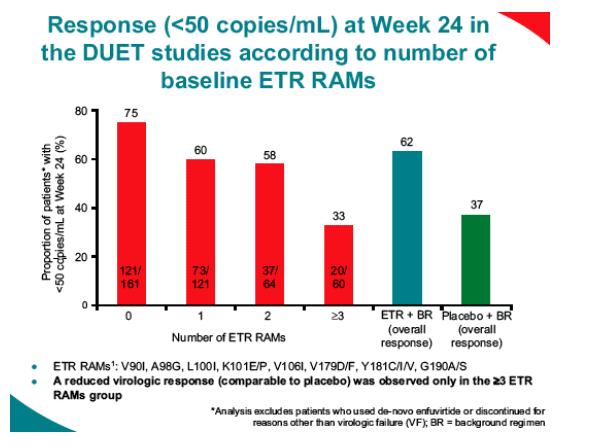
Methods
A total of 226,491 samples were submitted to Virco for RCRT from January 1999 to June 2007. Samples were defined as NNRTI-resistant if they carried at least one NNRTI IAS-USA mutation (September 2006) or if the predicted fold change in EC50 for any currently approved NNRTI was greater than the respective vircoTYPE (vT) biological cut-off (BCO).
Results
89,113 and 95,019 samples, respectively, met the definition of having NNRTI resistance according to the IAS-USA mutation list or vT BCO. Forty percent of isolates with NNRTI resistance, defined by the IAS-USA list, contained no ETR RAMs, while 36.7%, 16% and 7.3% harbored 1, 2, and 33 ETR RAMS, respectively.
In the same subset (n=89,113), the ETR RAMs occurring most frequently were Y181C (27.6%), G190A (21.1%), K101E (8.9%), L100I (7.6%), V90I (6.9%), A98G (6.4%), G190S (4.3%) and V106I (3.5%). The other five ETR RAMs had a
prevalence of <3%.
Among all NNRTI-resistant samples with two ETR RAMs (n=14,258) the most frequent combinations were: Y181C+G190A (27.1%), K101E+G190A (12.5%) and V90I+Y181C (7.0%).
While the proportion of NNRTI-resistant samples with ETR RAMS declined over time (69.9% in the first semester in 1999 to 54% in the first semester in 2007) and the prevalence of some ETR RAMS changed (Y181C declined from 44.9 to
20.7%, V106I increased from 2.1 to 4.8%), the ratio between isolates with 1, 2, or >/= 3 ETR RAMS remained relatively constant (~5:2:1). Similar results were observed in samples with NNRTI resistance defined by the vT BCO (n=95,019).
Objectives
To study the prevalence of each ETR Resistance Associated Mutation (RAM) and the frequency of various combinations in a large number of samples received for routine clinical resistance testing (RCRT)
To study the prevalence of ETR RAMs over time.
Methods
226,491 samples were submitted to Virco for RCRT from January 1999 to June 2007
- samples from clinical trials (including DUET) were excluded
Samples were defined as NNRTI resistant if
- they carried at least one NNRTI IAS-USA mutation (IAS-USA September 2006) (Subset A)
- the predicted fold-change in EC50 (FC) for any currently approved NNRTI (excluding ETR) was greater than the respective vircoTYPE HIV-1 (vT) biological cut-off (BCO) (Subset B)
ETR RAMS1
- V90I, A98G, L100I, K101E/P, V106I, V179D/F, Y181C/I/V, G190A/S
The prevalence reported is in a broad patient population
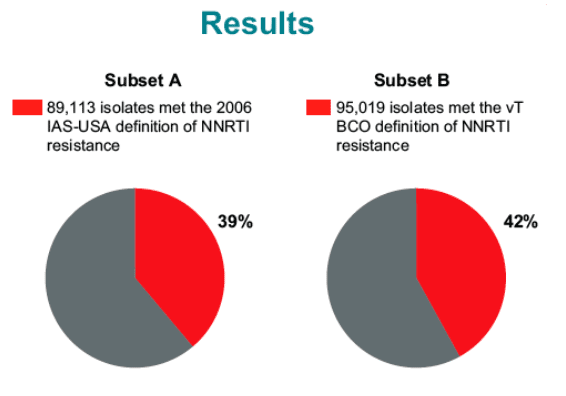
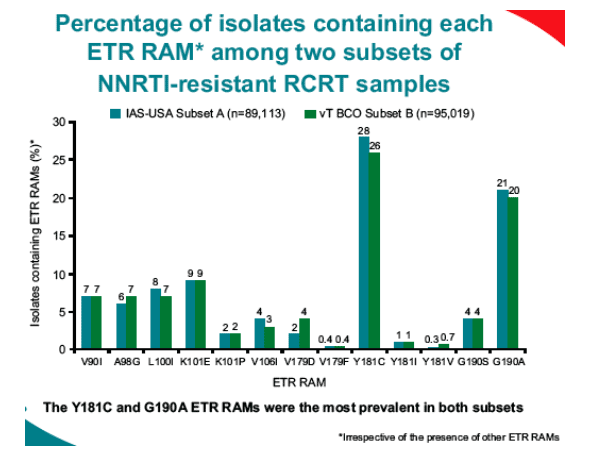
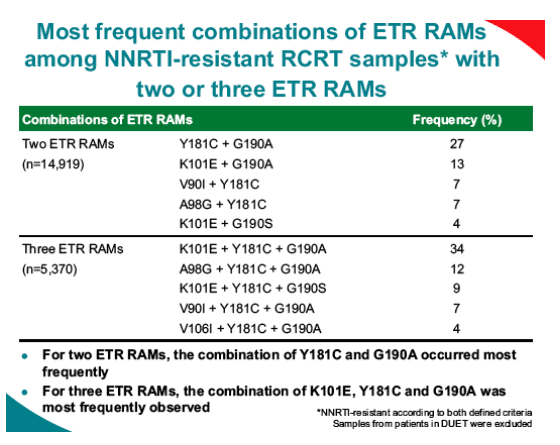
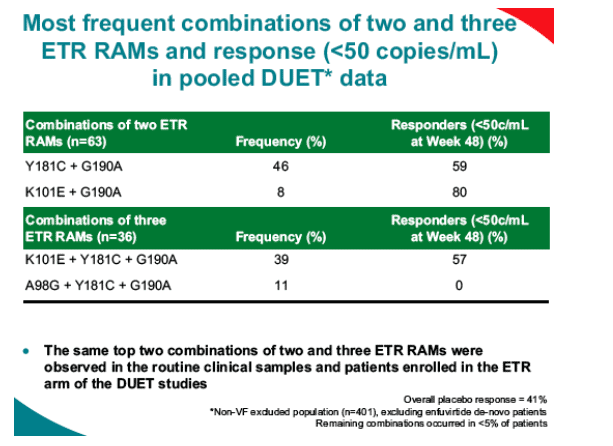
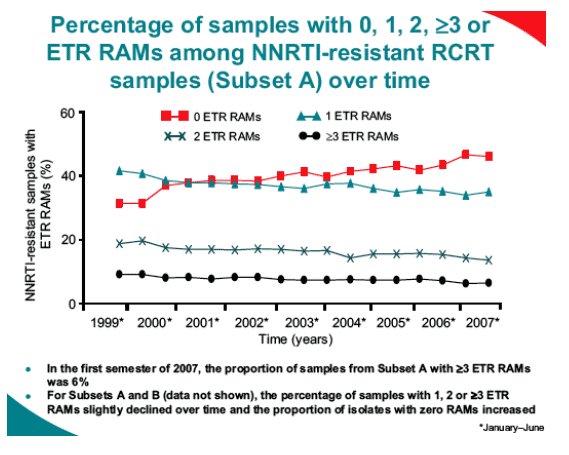
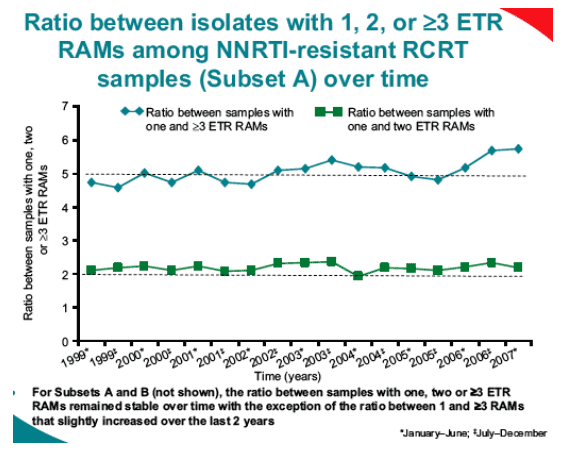
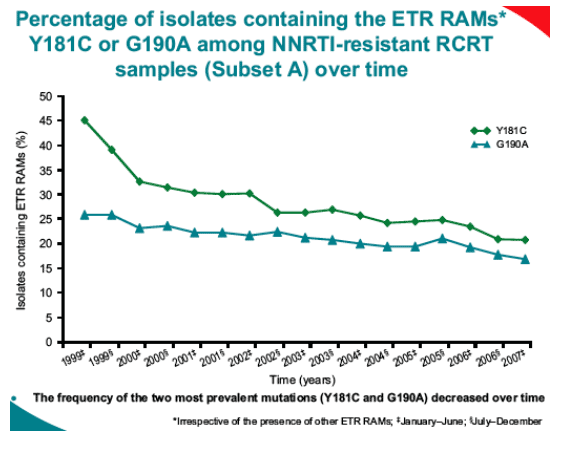
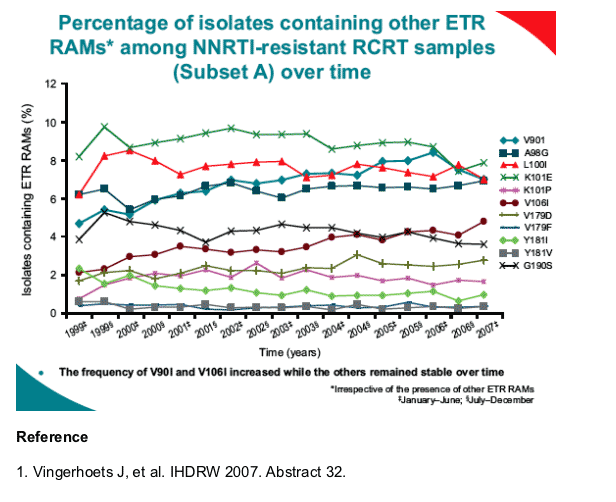
|
| |
|
 |
 |
|
|